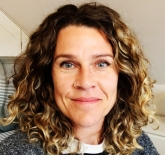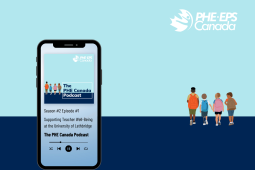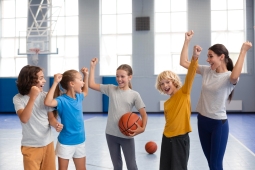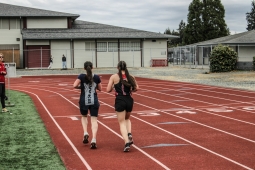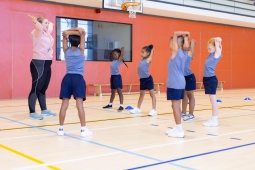Youth as Changemakers: Redefining Violence Prevention
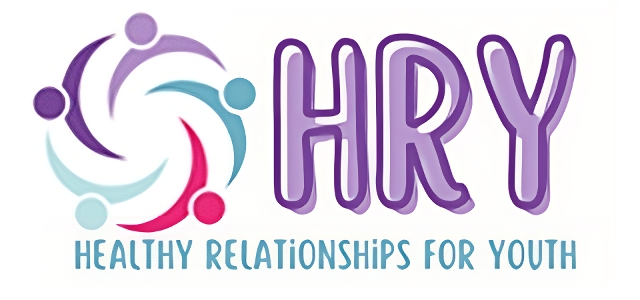
"Adolescence is a time of profound growth and change, and few forces shape this period more than the influence of peers—especially in the dynamic environment of schools.". In Health Education (HE) learning environments, students’ need to find relevance, meaning, and see themselves in their education. When they feel valued, reflected, welcomed, and seen as a contributing member of their unique learning environment, students' diverse interests and needs can be better met (Davis et al., 2023). By adopting a student-centered learning approach in HE, students are provided with opportunities for student agency and ownership, encouraging the development of life skills and competencies needed to support their health and well-being throughout the life span.
Globally, school-based peer health education programs have proven to be highly effective in enhancing health literacy and promoting healthier behaviours among youth (Blackemore et al., 2012). In this PHE Journal Community Spotlight feature, we interview an innovative and transformative program in Nova Scotia, Healthy Relationships for Youth (HRY), who have been champions in adopting and effectively utilizing a student-centered learning and youth-facilitated approach to educating high school students on healthy relationships and violence prevention.
What is Healthy Relationships for Youth (HRY)?
Healthy Relationships for Youth (HRY) is an impactful school-based, violence prevention program that empowers students through peer facilitation. Developed by the Antigonish Women's Resource Centre and Sexual Assault Services Association (AWRCSASA), HRY partners with high schools throughout Nova Scotia to engage students in vital conversations about healthy relationships. The program's core mission is to reduce youth violence by instilling vital skills and understanding for fostering healthy relationships. By focusing on student-centered learning and violence prevention through a diversity lens, HRY prepares students with crucial skills for healthy relationships while employing a trauma-informed approach.
How does Healthy Relationships for Youth develop its program? What types of activities and learning opportunities are provided to youth?
"It's crucial that every school does this. So important for prevention." - Teacher, Healthy Living 9 (interview, 2023)
In this innovative program, Grades 11 and 12 students receive youth-facilitator training for leading a series of twelve engaging, one-hour sessions for Grade 9 students in collaboration with their Healthy Living (Health Education) educator.
- Session 1: Healthy Relationships for Youth
- Session 2: Relationship with Yourself
- Session 3: Interpersonal Relationships
- Session 4: Consent and Personal Boundaries
- Session 5: Communication and Conflict Resolution
- Session 6: Diversity, Inclusion, and Privilege
- Session 7: Self-Identity and Self-Expression
- Session 8: Gender Norms and Stereotypes
- Session 9: Social Media and Relationships
- Session 10: Drugs, Alcohol, and Decisions
- Session 11: Power and Violence
- Session 12: Where are we now?
These sessions equip youth with essential skills and knowledge (e.g., consent and personal boundaries, conflict resolution, navigating healthy relationships online, etc.) to foster and maintain healthy relationships, effectively reducing the risk of violence. This approach not only empowers older students as change makers, but also creates supportive and safer learning environments for younger peers.
HRY emphasizes robust training for youth-facilitators with a day-long session at the beginning of the program. It also provides on-going support to the youth facilitators and Health Educators throughout the duration of the HRY program by conducting regular check-ins. Through this, the Grades 11 and 12 facilitators develop critical skills in leadership, facilitation, and critical thinking, which they utilize to strengthen their contributions in the classroom and beyond.
"Through HRY I learned more about the relationships in my own life and how to communicate with people in a healthy way." - Youth Facilitator, cis-girl (post-program survey response, 2023)
HRY participants consistently report increased confidence in public speaking and leadership, enhanced awareness of youth issues, improved personal relationships, and active participation in social initiatives. By emphasizing learning through collaboration, HRY helps to shape school culture and build a healthy and connected school community.
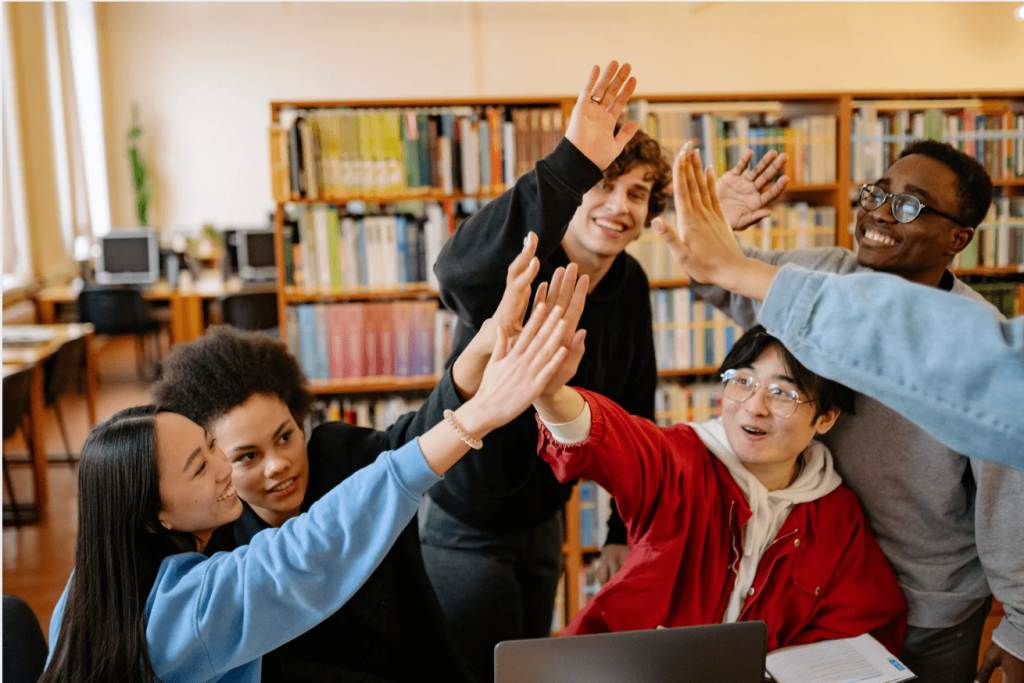
The impact Healthy Relationships for Youth has on students, Health educators, and their school communities are invaluable. Can you share more about your journey?
HRY’s youth-to-youth approach is one of its most powerful assets. Since its launch in 2006, HRY has made a significant impact in 24 Nova Scotia schools, training around 500 youth-facilitators and benefiting approximately 1,500 Grade 9 students.
"I found the part where the HRY facilitators communicated with us was the most meaningful. Sometimes people just need someone to talk to." Grade 9 student, cis-girl (post-program survey response, 2023)
In recognition of its success, the Public Health Agency of Canada (PHAC) and the Nova Scotia Advisory Council on the Status of Women have committed additional funding to enhance the reach of HRY. This substantial investment—totaling $2.5 million—will allow HRY to expand its reach to even more schools and students, targeting around 76 high schools with Grade 9 students across the province. Importantly, this funding ensures that there will be no costs for schools, facilitators, or participants involved in the program.
Given the complexities of addressing violence prevention in Health Education, what drives the Healthy Relationships for Youth program's choice to adopt a youth-led, youth-facilitated approach in understanding and fostering healthy relationships?
"HRY has improved my knowledge of everything the sessions were about which has made me a better overall person." - Youth Facilitator, cis-boy (post-program survey response, 2023)
The strength of youth-to-youth communication is unparalleled; youth can speak directly and authentically in relatable terms, arising from shared cultural experiences—energized by the absence of social control and hierarchy (Dodd et al., 2022; Stine Kjaer Wehner et al., 2022). A growing body of evidence has shown the following reasons why peer-led health education programs are successful:
- Young people prefer seeking help from friends regarding health and well-being rather than from educators or adults (Lam et al., 2014), frequently looking up to older peers as role models (Johnson et al., 2015),
- Peers are often seen as relatable figures, presenting a more approachable alternative to educators (Winterton et al., 2020).
- The concept of "peerness"—sharing experiences, concerns, and credibility—enables youth to communicate effectively about health issues in ways that resonate deeply with one another (Widnall et al., 2024).
- For younger students, older peers are viewed as credible sources of advice (Widnall et al., 2024).
- Youth led sessions on social issues have demonstrated greater effectiveness than those led by professionals, as participants find these discussions far more engaging and relatable (Widnall et al., 2024).
- Peer facilitation actively dismantles power imbalances (Gafney, 2012).
- Youth led programs significantly benefit facilitators who receive thorough training and support from educators and coordinators, with tailored on-site training enhancing knowledge, attitudes, and practices related to health promotion (Cramer et al., 2015).
Evidence strongly supports that combining innovative environmental changes with educational programs can effectively influence behavior. Additionally, incorporating peer educators who reflect the diverse demographics of their audience—considering factors such as age, gender, and lived experiences related to health conditions or behaviors—plays a crucial role in fostering connectedness, belonging, and social cohesion within school communities.
What are some ways Healthy Relationships for Youth address challenges and/or barriers that young people may experience in regards to accessing Comprehensive Health Education?
"Peer education approach breaks down barriers, creates connection between younger and older students." - Teacher, Healthy Living 9 (post-program survey response, 2023)
In today’s ever-evolving social landscape, empowering young people with the skills to navigate complex interpersonal relationships is more important than ever. HRY addresses this need through a proactive approach, utilizing a Comprehensive School Health Framework to seamlessly integrate education and awareness about health and relationships into the lives of adolescents.
By emphasizing a strength-based and inclusive framework, HRY empowers students to recognize and address various forms of violence, such as sexism, racism, ableism, homophobia, and transphobia. Since its launch in 2006, HRY has been continually evaluated, adapted, and updated by the AWRCSASA in response to the needs of its participants. A key feature of the program is its commitment to creating a sense of connectedness and belonging within school communities. Youth educators represent diverse demographics, ensuring that all students can see themselves reflected in the program. This diversity not only fosters a sense of belonging but also enhances social cohesion among students.
"HRY impacts school culture. [It] increases knowledge on gender-based violence, boundaries, consent, relationship violence. [HRY] raises the profile of the concept of gender-based violence. [There's an] annual expectation of the program in Healthy Living class. The program has become a part of the fabric of the school." - Teacher, Healthy Living 9 (post-program survey response, 2023)
"Seeing the progress and growth of the kids each session was the most meaningful." - Youth Facilitator, cis-girl (post-program survey response, 2023)
Additionally, each year the HRY program undergoes rigorous evaluation to measure its effectiveness and maintain the relevance of its content for young people. Through external evaluations, the impact of the program's significance shows that almost two-thirds of participants and nearly all youth facilitators report positive changes in behaviour as a result of their involvement with HRY. Furthermore, 77% of youth facilitators and 49% of participants feel that their schools have become safer environments due to the program's influence. These findings highlight the program's success in providing essential knowledge about healthy and unhealthy relationships, consent, and gender identity.
What’s next for the Healthy Relationships for Youth program? And, where do you see the future of Health Education in Canada?
The recognition of HRY's effectiveness has been recognized both provincially and nationally. Awards such as the 2013 Minister's Award in Crime Prevention and recognition from the Nova Scotia Child and Youth Strategy exemplify the program's commitment to excellence in promoting healthy relationships. Additionally, endorsements from organizations such as the Public Health Agency of Canada, Mass Casualty Commission, and the Nova Scotia Advisory Council on the Status of Women further validate HRY's impact in fostering safer and inclusive school communities. As the program evolves, HRY remains committed to incorporating youth voices, educator feedback, and emerging issues into its framework. By updating the curriculum annually, the program ensures its content stays relevant to the real-life experiences and challenges faced by today’s youth.
"I thought every lesson was meaningful in its own unique ways teaching us many valuable things." - Grade 9 student, cis-boy (post-program survey)
The ongoing support from community partners, schools, and organizations is vital as HRY works towards the goal of eradicating violence against women and girls, ultimately contributing to a safer and more inclusive future for all Nova Scotians. The call to action is clear: more schools, universities, and social services organizations are encouraged to join the movement, champion gender equality, and invest in comprehensive HE programs that educate and empower young individuals on the importance of healthy relationships. Together, we can build a brighter future grounded in respect and understanding for all.
"Knowing that I was making a difference for youth relationships and future relationships by informing youth about important information, including consent, healthy vs non-healthy relationships, and treating people with equality." - Youth Facilitator, cis-girl (post-program response, 2023)
How can HE educators get connected and/or involved with Healthy Relationships for Youth to create long-lasting and valuable learning opportunities for their high school students and school community?
As the HRY program is expanding its reach in Nova Scotia schools, we invite Healthy Living educators in Nova Scotia with students in Grades 9 to 12 to seize this opportunity and be part of an initiative that is changing lives.
If you are an HE educator in other parts of Canada thinking of incorporating Youth Facilitators at your school:
Here are some tips-of-the-trade from our HRY Regional Coordinators:
- Involve as many Youth Facilitators as possible; this way each student misses fewer of their own classes.
- Play a lot of games - especially if those games get students physically moving around; no matter how old the Youth Facilitators are, or how mature they seem, they always like playing games, and it helps with team-building!
- Always provide snacks during any training sessions or meetings with Youth Facilitators - who doesn’t love Goldfish crackers?
- Try to be relatable; even if you are of a different generation, learn what's important to the students, what social media they're on, what music they listen to, etc.
- If you are a Youth Facilitator working with younger peers, make sure you have a few tried-and-true ways to get their attention; it is also a good idea to have a few ice-breakers or quick games in mind that you can run on the spur of the moment when you feel like the class needs a break or needs to refocus.
- Be open; without disclosing a lot of personal details, have open conversations with students and let them see who you are as a person (not just as an adult or as another authority figure).
- Be flexible; if the lesson or activity you planned isn't working, adapt to what the students need that day as much as you can.
- Try to balance teachable moments (a student asks an off-topic but important question) with going down rabbit holes (when your answer to that question sparks a 20 minute class discussion).
- Have fun!
Check out the following additional resources:
-
Antigonish Women’s Resource Centre & Sexual Assault Services:
Student-Centered Learning Resources from PHE Canada:
- Student-Centered Learning Toolkit for Engaging Students in School-Based Initiatives
- Incorporating Student Voice and Choice in Teaching and Learning
- Gathering Student Feedback About Teaching and Learning
References
Blakemore SJ, Robbins TW. Decision-making in the adolescent brain. Nat Neurosci. 2012; 15(9):1184–91. https://doi.org/10.1038/nn.3177 PMID: 22929913
Davis, M., Gleddie, D.L., Nylen, J., Leidl, R., Toulouse, P., Baker, K., & Gillies, L. (2023). Canadian physical and health education competencies. Ottawa: Physical and Health Education Canada.
Lam CB, McHale SM, Crouter AC. Time with peers from middle childhood to late adolescence: developmental course and adjustment correlates. Child Dev. 2014; 85(4):1677–93. https://doi.org/10.1111/cdev.12235 PMID: 24673293
Cramer, E. P., Ross, A. I., McLeod, D. A., & Jones, R. (2015). The Impact on Peer Facilitators of Facilitating a School-Based Healthy Relationship Program for Teens. School Social Work Journal, 40(1), 23–41.
Dodd, S., Widnall, E., Russell, A.E. et al. School-based peer education interventions to improve health: a global systematic review of effectiveness. BMC Public Health 22, 2247 (2022). https://doi.org/10.1186/s12889-022-14688-3
Gafney, L. (2012). Peer-Led Team Learning: Evaluation, dissemination and institutionalization. Online: http://pltlis.org/wp-content/uploads/2012/10/Evaluation-Gafney-II-Dissemination-plus.pdf
James, M. H., Porter, J. E., Kattel, S., Prokopiv, V., & Hopwood, P. (2022). Peer Educators in the Facilitation of Sexuality and Respectful Relationship Education for People with an Intellectual Disability: A Scoping Review and Narrative Synthesis. Sexuality and Disability, 40(3), 487–502. https://doi.org/10.1007/s11195-022-09740-4
Sherman, A., Balthazar, M., Kim, S., Carroll, L., Casseus, K., & Febres-Cordero, S. (2023). Peer facilitation: Accelerating individual, community, and societal change. Advances in Peer-Led Learning, 3, 18-33. Online at https://doi.org/10.54935/apll2023-01-03-18
Stine Kjær Wehner, Tine Tjørnhøj-Thomsen, Camilla Thørring Bonnesen, Katrine Rich Madsen, Marie Pil Jensen, Rikke Fredenslund Krølner, Peer mentors’ role in school-based health promotion: qualitative findings from the Young & Active study, Health Promotion International, Volume 37, Issue 2, April 2022, daab089, https://doi.org/10.1093/heapro/daab089
Widnall, E., Dodd, S., Russell, A. E., Curtin, E., Simmonds, R., Limmer, M., Kidger, J., & Matlala, S. F. (2024). Mechanisms of school-based peer education interventions to improve young people’s health literacy or health behaviours: A realist-informed systematic review. PloS One, 19(5), e0302431-. https://doi.org/10.1371/journal.pone.0302431
Wyman PA, Brown CH, LoMurray M, Schmeelk-Cone K, Petrova M, Yu Q, et al. An outcome evaluation of the Sources of Strength suicide prevention program delivered by adolescent peer leaders in high schools. Am J Public Health. 2010; 100(9):1653–61. https://doi.org/10.2105/AJPH.2009.190025 PMID: 20634440

